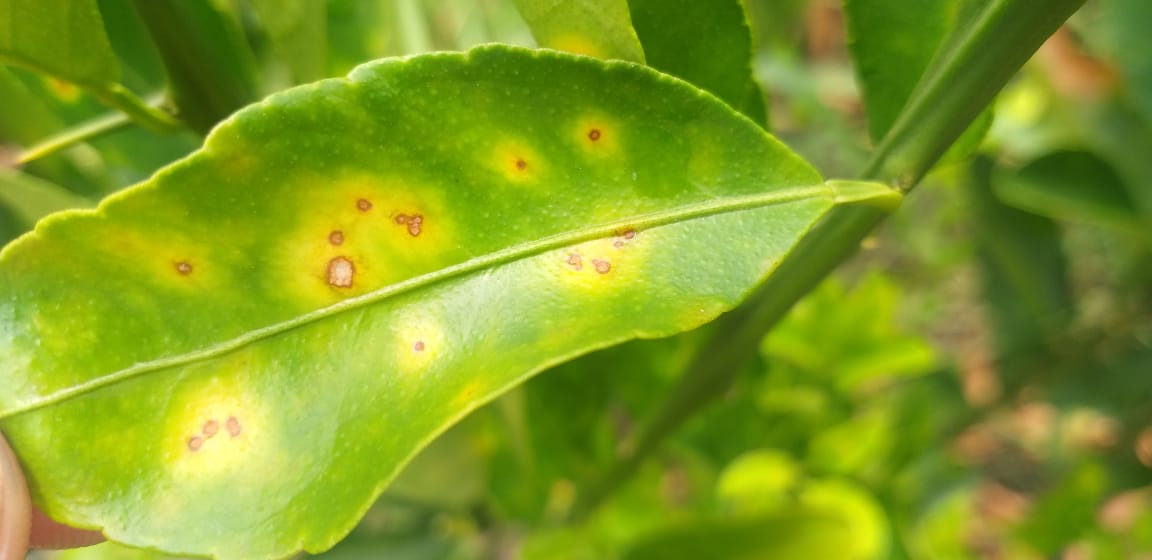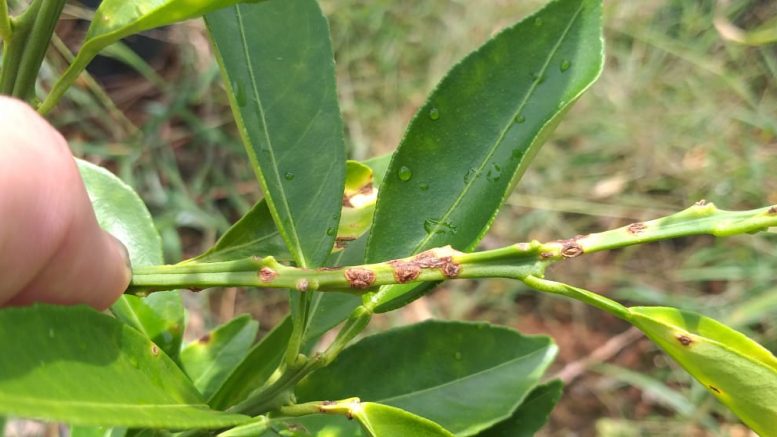“Due to the ease of spread, citrus canker is a major threat to citrus farming in the State of Minas Gerais…”
Leonardo do Carmo is manager of plant health defense at the Minas Gerais Institute of Agriculture – IMA, coordinator of the Technical and Thematic Chamber of Agricultural Defense of the Secretariat of Agriculture, Livestock and Supply of Minas Gerais, has a degree in agronomy and a M.Sc. in plant health defense from the Federal University of Minas Gerais.

Leonardo do Carmo, manager of plant health defense at IMA
AgriBrasilis – Is citrus canker a threat to citrus farming in the State of Minas Gerais? What damage can this disease cause?
Leonardo do Carmo – Due to the ease of spread, citrus canker is a major threat to citrus farming in the State of Minas Gerais. The greatest losses brought by this pest are the increase in the production costs, the restriction of trade and the losses of production, if there is no correct management.
AgriBrasilis – How does the spread of the disease occur? Why can this process be so fast?
Leonardo do Carmo – The spread of citrus canker occurs through winds, rain, contaminated tools, vehicles, contaminated seedlings, and even people. The process is fast due to the characteristic of the bacterium Xanthomonas citri subsp. citri, which causes the disease. This bacterium has a “polar flagellum”, which facilitates its locomotion in a water depth, penetrating the plant through natural openings or wounds. The development of the disease occurs preferentially at temperatures of 25° to 30° C and high humidity, which happens mainly in the spring and summer seasons in the State of Minas Gerais.
AgriBrasilis – What are the symptoms and how is the disease confirmed? If so, what actions should be taken?
Leonardo do Carmo – Symptoms of citrus canker occur first on the leaves, on the underside with a yellowish spot, developing to brown pustule and with the rapid progress of the disease. It is also possible to observe the lesion with corresponding protrusion on both sides of the leaf. Then, the pest reaches the stem of the plant and reaches the fruits. Subsequently, there is the fall of the diseased leaves.

Source: IMA
When the disease is suspected, the farmer must report the fact to the IMA urgently, so that we can verify the situation, collect material and send it for laboratory analysis.
The property is then interdicted until the laboratory result is ready. During this period, fruits are not allowed to leave the farm, as a precautionary measure to avoid dissemination to other regions.
In case of a positive result, we notify the farmer to carry out the eradication, i.e., destruction of the production and we carry out a survey in all neighboring properties, to verify the health situation of the citrus plants. The property affected by the disease is closed for 180 days after the last outbreak has been eliminated.
If symptoms of the disease are found in other properties in the municipality and the reports are positive for citrus canker, we adopt the same measures and request the change of the municipality’s health status with the Ministry of Agriculture and Livestock (MAPA), to the Risk Mitigation System (SMR).
This change in health status is important for farmers to adopt control measures to live with the pest, preventing its spread to other municipalities or regions.
“The main means of preventing citrus canker is to acquire healthy and regular seedlings from the plant health defense agencies of each state.”
AgriBrasilis – How to prevent the occurrence of the bacterium Xanthomonas spp Xanthomonas citri subsp. citri, which causes citrus canker??
Leonardo do Carmo – The main means of preventing citrus canker is to acquire healthy and regular seedlings from the plant health defense agencies of each state. It is possible to certify the health of these plants through the required sanitary documentation.
In addition, it is important to use sanitized plastic boxes, windbreaks in the orchards and disinfestation of vehicles at the entrance of the property.
Other means of prevention are to avoid plant injuries in cultural tracts and to control the access of people to the properties.
AgriBrasilis – What control methods are recommended?
Leonardo do Carmo – The main methods of control are the control of the Citrus Miner, which causes injuries to the plants, facilitating the entry of the bacteria, the cleaning of the tools used in the treatment of citrus plants, the use of metallic copper to prevent entry through the natural openings or injuries of the plant and the destruction of contaminated fruits.
AgriBrasilis – What is the importance of CFO/CFOC issuance qualification courses and what are these certificates for?
Leonardo do Carmo – In the CFO/CFOC courses, we train agronomic engineers to guide farmers on prevention measures in regions without occurrence of the pest. These professionals are also trained to identify citrus canker, who can notify the suspicion with the IMA as soon as possible.
For regions where there is sanitary and SMR status, the professionals provide guidance on the management to be adopted and carry out all the follow-up.
Both the CFO and CFOC ensure the health of plant products. The farmer, in order to transit with citrus fruits, needs the Vegetal Transit Permit. This document is issued by the IMA upon presentation by the CFO or CFOC.
AgriBrasilis – What other pests and diseases have caused concern in Minas Gerais?
Leonardo do Carmo – Another pest that causes enormous concern for citrus farming in Minas Gerais is Huanglongbing (HLB), known as greening, which today is the worst pest in the national citrus industry.
AgriBrasilis – What IMA projects and actions contribute to the health of crops in Minas Gerais?
Leonardo do Carmo – The IMA carries out periodic inspections of crops in all citrus producing regions in Minas Gerais and it also inspects these properties to verify compliance with plant health standards.
The IMA also checks the traffic to prevent the entry of pests or the spread to regions that do not have occurrences, we also carry out health education work with students, children, adolescents, university students, along with the production chain and professionals who serve rural producers. To ensure the efficiency of the plant health service, we also carry out training for our employees, who perform these actions.
READ MORE:

